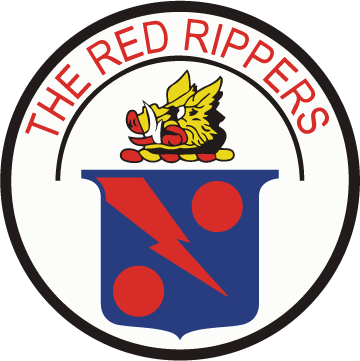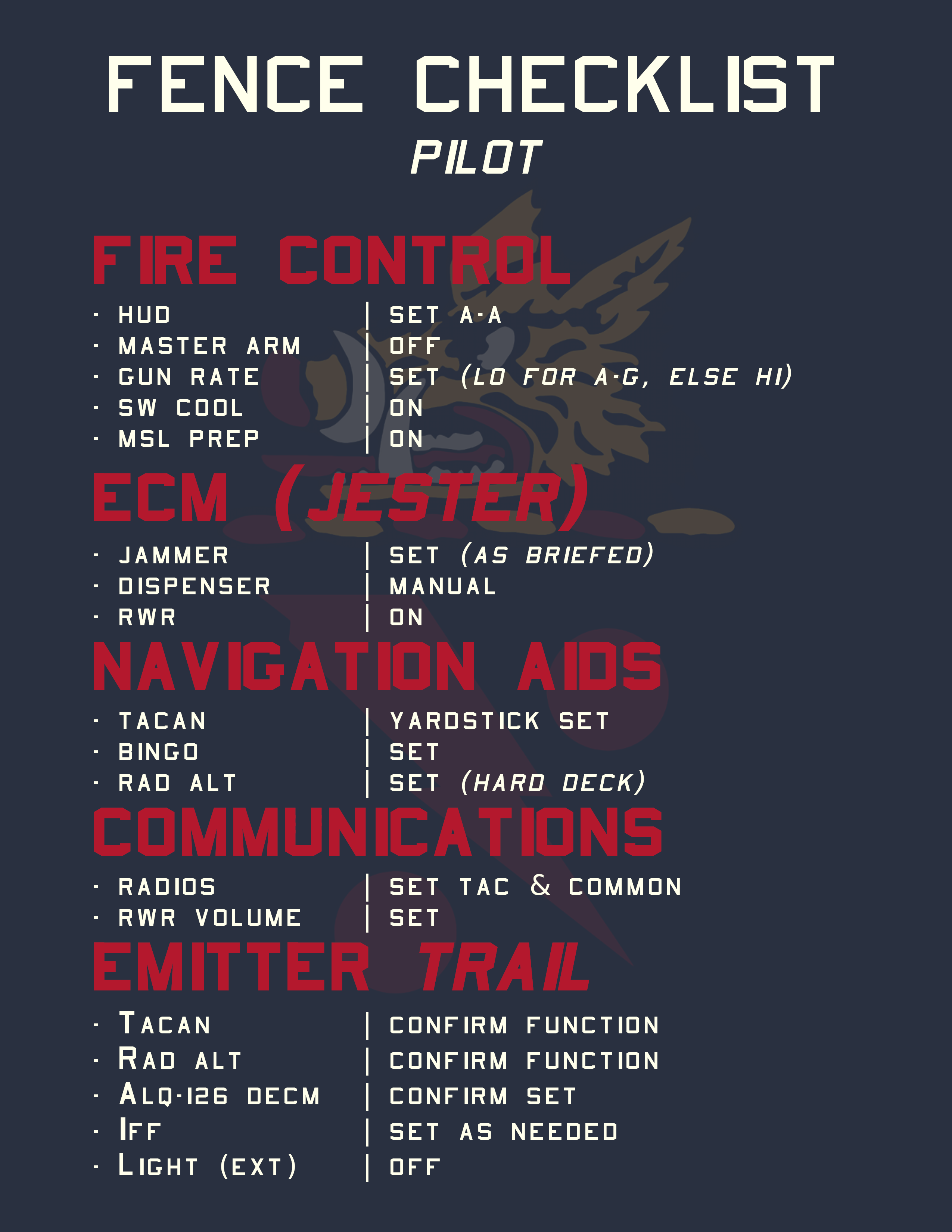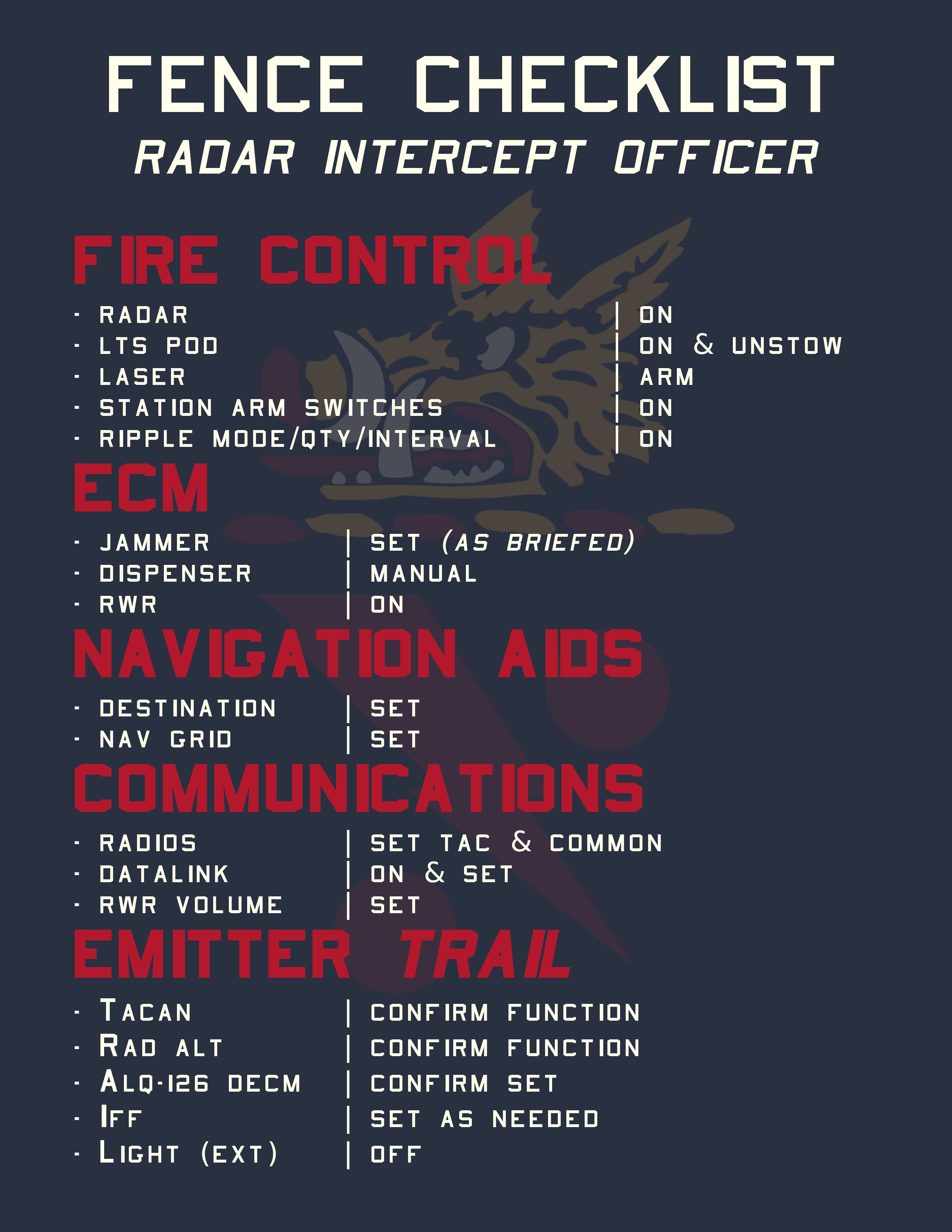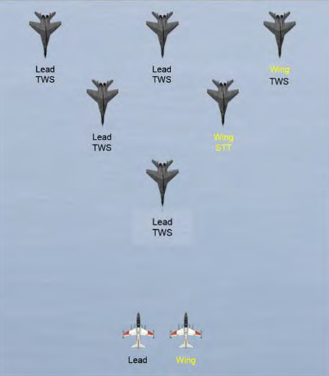
¶ Introduction
The goal of the Fighter Squadron 11 Standard Operating Procedures document is to provide members with relevant information on how VF-11 operates within DCS multiplayer missions. This document is intended to capture the best practices and procedures for VF-11, to serve as a reference for how vCSG-8 operations should normally progress, and what members of VF-11 should expect when participating with the squadron.
It is expected that the ranks of Lieutenant and above be familiar with the document and provide assistance to other members if requested.
¶ Roles and Responsibilities
¶ Mission Commander
The mission commander’s role is to coordinate the actions of all the flights in a particular operation or wave. This may include signaling all the flights to start ingressing into the vulnerable zone (hostile territory). The mission commander will typically be either a flight lead or AIC.
¶ Lead aircraft
The lead pilot is responsible for ensuring that their flight understands the mission, the ROE, and the flight plan. The flight lead assumes primary responsibility for navigation and secondary responsibility for visual lookout. The lead pilot is responsible for execution of the flight plan and directing the usage of formations. Finally, flight leads should maintain awareness of the fuel and weapons state of their flight members.
Lead Pilots should be comfortably familiar with all aspects of F-14 operation related to their role and the mission.
The lead RIO is responsible for ensuring that their flight understands the mission, the ROE, and the targeting procedures. The lead RIO assumes primary responsibility for radar lookout and directing the radar mating plan. They also assume primary responsibility for commit and targeting decisions. Post-commit, the LRIO should assertively dictate the flow of the engagement to their flight members.
Lead RIOs should be comfortably familiar with all aspects of F-14 operation related to their role and the mission.
¶ Wing aircraft
The wing pilot is responsible for supporting the flight lead in completing the mission. This support mainly comes from proximity and distribution of roles; therefore the wingman is less concerned with navigation and more concerned with visual lookout. The wing pilot stays close to the flight lead, maintaining the assigned formation. While the lead pilot and RIO usually talk, the wing pilot mostly just listens.
The wing RIO is responsible for supporting the flight lead in completing the mission. This support mainly comes from executing the mating plan directed by the lead RIO. During intercepts, the wing RIO is responsible for executing the briefed sorting plan and employing on the correct target.
¶ Section 1 - Communications
¶ 1.1 A Note on Brevity
The vCSG-8 website lists a variety of brevity codes used within our community, the vast majority of which are standard to the US Department of Defense and the flight sim community at large. While proper usage of brevity codes can facilitate speedy and precise communication, it is more important to say what you need to say quickly and to get your information across. It is totally acceptable to use plain English to communicate on the radio when you don’t know applicable codewords. However, do NOT try to fumble your way through a transmission without thinking it through first, as this will likely only confuse listeners.
Raider Two-Two, Fox-THREE Flogger Bulls Zero-Five-Zero for Twenty.
What’s the TACAN for ARCO?
Senator Fifty-One, Pitbull on that ship chilling in the harbor at uh…Bassel al-Assad. Yea %^#$ that dude.
If you are unfamiliar with a brevity codeword that someone else uses, ask! Many brevity terms have meanings that are not obvious, could be easily misconstrued, or that are misunderstood by portions of the DCS community.
¶ 1.2 Background and Techniques
¶ 1.2.1 Radios in the F-14
The F-14 utilizes two different radios: the pilot’s ARC-159 UHF (aka FRONT) radio and the RIO’s ARC-182 V/UHF (BACK) radio. Standard practice for VF-11 is for the pilot to “set and forget” the FRONT RADIO to channel Preset 3, also known as intraflight. The RIO’s BACK RADIO is utilized for common frequencies, such as the carrier tower, AWACS, or even a JTAC.
¶ 1.2.2 Elements of a radio transmission
Radio communications fall into two categories of “Descriptive” and “Directive” messages.
- Descriptive comms are intended to convey information from one station to another. Descriptive comms generally follow a standard format of
“[Recipient], [Sender], [Message]”.Recipients of descriptive comms should acknowledge receipt by saying their own callsign or flight number.
Ripper Two, Ripper One, Nails Guideline Two O’clock
Two
- Directive comms are used to direct pilots to take specific actions. Directive comms generally follow a standard format of
“[Recipient], [Command]”.Recipients of directive comms do not need to verbally acknowledge the command, instead they should safely and correctly execute the given directive.
Two, break left! SAM launch!
¶ 1.2.3 Vocal Technique
How you talk on the radio can convey as much meaning and significance as what you say. Therefore it is important to use the correct tone and inflection when sending descriptive or directive communications. Think about what you intend to say before you key the mic. While this can be difficult under stress, it will go a long way towards keeping your delivery concise and allowing everyone a chance to use the channel. Remember that in SRS, not only can you not hear anyone else transmitting while you are transmitting yourself, but anytime two or more stations transmit on the same channel, it sounds an alarm tone that prevents anyone from hearing anything on the channel.
-
For descriptive comms, use a neutral tone of voice. Try to speak clearly, like you’re giving a presentation. While some messages can take a long time to send, do not stay keyed up for more than a single sentence at a time. Take brief pauses to allow higher-priority traffic a chance to filter in.
-
For directive comms, use an authoritative, assertive tone of voice. Use inflection to help grab the attention of the intended recipient. Use simple, active verbs whenever possible.
¶ 1.3 Standard Procedures
¶ 1.3.1 Keep the Channel Available
The number of speakers on the radio need to be minimized, and the order of speakers needs to be standardized, for the following reasons:
-
There is a limited amount of time available to send and listen to each transmission.
-
A large number of transmissions increases the odds that two transmitters will block each other.
-
In high-stress situations, transmissions are missed due to task saturation or auditory exclusion.
-
People tend to tune out conversation that is repetitive, or unrelated to them, and it can be difficult to quickly regain their attention.
-
Time spent listening or talking on the radio is time not spent doing other tasks.
-
Try to pay attention to other transmissions, If someone is communicating with someone directly, then do not interrupt the transmission until the recipient is done transmitting and has acknowledged the information. If its a question then wait for the recipient to answer before transmitting.
¶ 1.3.2 Assigned Speakers and Flow
Aircraft should designate ONE aircrew to be the main speaker on the radio.
In a 2-ship flight, wingmen should only report contacts not reported by other players.
In a 4-ship flight, wingmen (-2 and -4) should speak only by exception, i.e. to report an untargeted group inside weapons range.
Allow long enough pauses between transmissions for everyone to process the information, before starting your own transmission.
-
Listen to conversations even if they don’t involve you, as they will build your SA.
-
This does not apply to critical directive comms i.e. “2, break right!”.
-
If the entire flight is a 4 ship and the lead decided to seperate into 2 section’s, then 3 and 4 should remain off the net until commited and 1 and 2 are flowing OUT. This is to ensure both sections arent stepping on eachother while trying to give important information.
WHEN IN DOUBT: Flight Leads should OVER-communicate, others should under-communicate.
RECOMMENDED: Use of NATO codenames over numbers. NAILS FOXBAT TWO O'CLOCK instead of NAILS (MiG) 25 TWO O'CLOCK. The number could be misconstrued as altitude or distance while in a stressful situation. Say the number if you don’t know the callsign!
¶ 1.4 Communication Types
¶ 1.4.1 Administrative
Flight Leads should be the first to check in to a new frequency. Wait 10-15 seconds after switching channels to ensure that you are not interrupting a conversation. If checking in to an AIC frequency with all briefed aircraft, check in should be “as fragged”. If down aircraft, i.e. due to technical issues, check in should give the number of aircraft in the flight.
¶ 1.4.2 Interception
Throughout the entire interception, members of the flight should utilize the same format that their flight leader uses. Sometimes the format might change based on situational awareness degradation, or if a different format is more viable even if situational awareness remains high. Brief descriptions of each of the three main formats are displayed:
- BRAA (Bearing, Range, Altitude, Aspect)
- The BRAA format is a quick and easy way of giving very specific aircraft/flights information. Due to the information being directed to a very specific BLUFOR player by the Air Intercept Controller, BRAA calls can be inaccurate for other members of the flight, and outright useless for other flights entirely.
-
BULLSEYE
- Used when establishing a theater-wide picture, BULLSEYE is centered on a briefed point of interest. Common BULLSEYE points are prominent lakes, moutains, coastal features, or potential hostile points of origin. Calls given with the prefix BULLSEYE bring attention to radar contacts radially from this established point.
-
AREO (Azimuth, Range, Elevation, Overtake {Vc})
- AREO calls are best made over the ICS as a form of Crew Resource Management to help the pilot achieve tally when transitioning from Beyond Visual Range combat to the Within Visual Range arena. AREO can work in a pinch when guiding radars within the section/division to a high priority contact only one aircraft may have on their scope.
20 [degrees] right, 10 miles, 5 [radar degrees] high, thousand knots [closure].
View the VICTORIA page on Air Intercept Control for more detailed descriptions.
Flight leads should establish a cadence for their transmissions post-commit, which is utilized by other players on the channel to deconflict transmissions.
- A common cadence is every 10-15 seconds, which for an air intercept should be cued by each 5NM of closure.
- Element leads (-3) should give their update after flight lead.
- AIC and wingmen should speak by exception to report untargeted groups, or at request. AIC should give updates when fighters do not have sensors facing the target.
- Some flight leads may prefer for AIC to give more frequent updates. It is recommended to set expectations in the mass brief.
Players should not repeat info that has already been transmitted.
CLOSEOUT: BRAA 040, 30, 20,000, HOT
DON’T: Zero Four Zero, Thirty Miles, Twenty Thousand, HOT
DO: Contact same
Players should focus their communications on building situational awareness both for themselves and others, from pre-commit up to the targeting phase of an engagement.
- DO: Determine as quickly as possible:
- How many bandit groups exist?
- What is the shape of the PICTURE?
- What are the closest groups on the PICTURE?
- What are the bandits doing? Are they aware or unaware of us?
- DO: Be prepared to adjust the sort plan based on whether wingmen see the whole picture.
- DON’T: Transmit unessential information when any friendly flights on the channel have committed.
Flight leads should transition from SA-building comms to targeting/sorting comms approximately 30 seconds (10NM) prior to reaching shot range.
- DO: Have a pre-briefed shot range for high and low altitude.
- DO: Have a pre-briefed sort plan that can be applied to various pictures.
- DO: If there is a need to deviate from the sort plan, flight lead should use either BRAA or AREO format to assign targets. All players on the channel need to be consistent with the format chosen by flight lead.
The flight member with the closest target should be the first to call their FOX.
¶ Section 2 - Flight Operations
¶ 2.1 Multiplayer Naming Conventions
Prior to entering the server for an official operation, a member will ensure that their displayed name for the server will be arranged as follows:
SIDENUMBER | TACTICAL CALLSIGN | PLAYER NAME OR CALLSIGN (optional)
Player names, and individual callsigns can be omitted as desired.
For example: 104 | RIPPER11 or 116 | SENATOR24 | DOE are both acceptable naming schemes.
¶ 2.2 Crew & Flight Composition
A full division of aircraft within VF-11 comprises four aircraft of pilot and RIO pairs for a total of eight aircrew;to facilitate communication comprehension, the divsion will split into two separate sections during FENCE in only if the flight specifically has four members. For three aircraft, the Dash 2 of the flight will fly “welded wing” with flight lead, or about 1000 feet separation, while Dash 3 spreads to the 1.5 nautical mile position the second wingman would normally take.
Division Lead (DL)
The DL is the most experienced and senior members in the flight.
Division Wingman (W1)
W1 is typically the member least current in the F-14, not necessarily least experienced. Guests from other squadrons should typically fly as a W1 unless they have qualified recently in the jet, in which case they should fly as a W2, if another more appropriate in-squadron member could fly as W1.
Section Lead (SL)
The SL is the second most experienced member in the flight. They are responsible for leading the flight and assuming the DL’s responsibilities if DL is incapacitated.
Section Wingman (W2)
W2 is the third most experienced member in the flight. Currency in the F-14 may be a useful metric to determine if a member should be W1 or W2 if they have not flown the jet in a while.
¶ 2.3 Briefing
Each mission typically begins with a 10-15 minute mass briefing, during which the situation, mission, and plan of execution are summarized by the mission maker. The mass briefing concludes with questions from flight leads only. After mass briefing, there will be a 10-15 minute period for flight leads to brief their flight members in further detail on the flight plan, and to reiterate important standard procedures. At the end of the flight briefing, the server will be unpaused and flights will start spawning on the carrier according to the briefed schedule.
Link to the VF-11 Flight Briefing Checklist VICTORIA page.
¶ 2.4 Deck Operations
To facilitate a speedy start to the mission, every aircraft must perform their required tasks and vacate the flight deck in a timely manner. Due to how the DCS: Supercarrier interacts with the F-14 Tomcat, if so much as ONE (1) F/A-18C Hornet spawns on the aircraft carrier, all subsequent F-14 Tomcats attempting to spawn will get the “FLIGHT DELAYED TO START” message. This message carries the potential to double the weight of the affected Tomcat’s ordnance.
Be courteous to your community members and clear the deck ASAP. Nobody likes waiting 50 minutes in spectator mode.
Pilots should spawn their jets solo, without a RIO in order to avoid certain DCS bugs. RIOs may join their pilot on the carrier deck after they spawn the jet.
¶ 2.4.1 Aircraft Configuration
Once the game has fully loaded your aircraft on the carrier, configure your aircraft with the following information:
- Open the Rearm & Refueling window with Left Alt + ', confirm your loaded ordnance aligns with what was briefed either by the mission commander or flight leader.
- If carrying laser-guided ordnance, confirm or modify your laser code by opening your kneeboard using Right Shift + K. Consult the Laser Code Deconfliction Plan VICTORIA page or the mission briefing to find your correct code.
- Change your livery and modex number to be congruent with your assigned modex in the flight composition tab of the roster.
Open the canopy slightly or switch your
INTERPHONEmicrophone toHOT MICto hear the crew chief tell you when rearming is complete.
- Tune the
FRONT RADIOtoPreset 3and verify the frequency matches the mission briefing materials by selectingREADon theFRONT RADIOcontrol panel, or set as prescribed by the vCSG-8 communication plan VICTORIA page if no specific plan was provided.- Perform a radio check on the
FRONT RADIO: “[flight name, position], radio check on {Radio Frequency}.”
Ripper Two, radio check on two seven five point zero.
- Perform a radio check on the
- Once you get confirmation from the crew chief, request taxi to a catapult if the carrier has a human controller, otherwise taxi at your discretion.
¶ 2.4.2 Taxi, Launch, and Rejoin
To avoid issues with the carrier deck crew not responding and thus disabling ALL catapults, it is highly encouraged for Tomcats to utilize catapults One (starboard bow) and Three (starboard waist) only. When you’re in tension and the shooter is giving you the spool up command, request a launch from the tower (if controlled) or launch at your discretion and follow the correct CASE I/II/III launch procedures.
For more information, visit the Carrier Operations VICTORIA page.
After completing a CASE I launch and reaching 7 NM, F-14s of Fighting Squadron 11 rejoin over the aircraft carrier starting at 10,000 ft MSL, increasing in blocks of 1,000 ft for every additional flight. Optimal holding pattern is a 15-20º left hand orbit at 225-235 knots.
¶ 2.5 Formations
¶ Cruise
Cruise formation is preferred when FENCED out. In cruise formation, the flight members remain on the 40-degree bearing line within .5NM. The advantage of this formation is that it is easy for wingmen to maintain.
¶ Combat
¶ 2-Ship
A single-section flight should stick to a standard combat spread (.8 to 1.0 NM abeam, wingman stepped up 1000 feet) when fenced in for day VFR missions. A wider formation without visual support, or even individual flight plans, may be briefed for night or IFR missions.
¶ 3-Ship
A 3-ship flight should operate together, similar to how a 4-ship division would fly in a visually supporting formation. If feasible (i.e. day VFR), the -2 wingman should fly in a close welded-wing formation to the flight lead, while -3 keeps a standard or widened combat spread.
¶ 4-Ship
A 4-ship flight should operate either together as a division, or as two independent sections, depending on the mission.
¶ 2.6 Recovery
Refer to https://victoria.vcsg8.com/en/intel/cvn-natops for full details.
Typically, each squadron will return to the carrier at a pre-briefed altitude block to start in the marshal stack.
Unless specified otherwise in the mission briefing, VF-11 will default to a 6000-foot stack altitude.
¶ Section 3 - Combat Flight Operations
¶ 3.1 FENCE Checklist


¶ 3.2 RADAR Mating Plan
Flight Lead: ±40 8-bar RWS, Azimuth slew left, Elevation Level
Wingman (-2): ±40 8-bar RWS, Azimuth slew right, Elevation Level
Flight Lead: ±40 8-bar RWS, Azimuth slew left, Elevation Level
Wingman (-2): ±40 8-bar RWS, Azimuth slew right, Elevation Level
Element Lead (-3): ±40 8-bar RWS, Azimuth centered, Elevation Level
Flight Lead: ±40 8-bar RWS, Azimuth slew left, Elevation Low
Wingman (-2): ±40 8-bar RWS, Azimuth slew right, Elevation High
Element Lead (-3): ±40 8-bar RWS, Azimuth slew left, Elevation High
Wingman (-4): ±40 8-bar RWS, Azimuth slew right, Elevation Low
¶ 3.2.1 Sorting

The flight should sort from left to right, if possible. Flight lead takes the left track or group, regardless of whether his wingmen are on his left or right side. -4 will take the contact furthest to the right.
If an azimuth sort is not possible, the flight should sort by range, where the flight lead takes the leading track or group.
If a range sort is not possible, the flight should sort by elevation, where the flight lead takes the low track or group.
If the flight’s formation is not well established, or if there are other complicating circumstances, the flight lead may direct deviations from the standard sorting doctrine.
¶ 3.3 Intercept Timeline
Pre-Commit describes when a fighter flight is fenced in and either at their assigned station, or on their flight plan in an area where air combat might take place.
-
DO: Maintain a lookout for threats (visual for pilots, RADAR for RIOs).
-
DO: Listen to the radio, and make SA-building communications as needed.
-
DON’T: Have unnecessary or off-topic conversations, even within an aircraft on ICS.
COMMIT is a directive/descriptive brevity term that describes that a fighter flight is leaving their CAP orbit or deviating from their flight plan to intercept one or more bogey groups.
-
DO: Maintain the briefed formation and assigned RADAR scan.
-
DO: Listen to the flight lead and AIC for targeting and range/closure information, and be prepared to MELD your RADAR scan zone onto your target group at about 10NM prior to shot range.
-
DO: Be ready to sort according to the sort doctrine, or flight lead directions.
-
DON’T: Repeat any information on the radio.
First shots should be made no later than crossing the briefed shot range. It is critical to ensure that one weapon is assigned to each track without any tracks going un-targeted.
-
DO: Call shots (“FOX 3”) in order of target range (this should roughly correspond to the order in which weapons are actually fired).
-
DO: Maintain the formation after shooting. Flight or element lead will determine maneuvers to be made after shooting (i.e. Crank).
-
DON’T: Maneuver independently of the formation in response to a threat launch warning.
-
DON’T: Call out SPIKED or any threat missile launches if one of the flight members has already called SPIKED - it’s unnecessary and takes up air time.
If the flight’s directed flow is SKATE (launch-and-leave tactics) or if shots are TRASHED on a BANZAI flow (launch-and-decide tactics), the flight or element lead may direct an OUT maneuver to separate from the target group. It is critical to maintain the formation and listen to the flight lead for further instructions.
-
DO: Peek at the RWR and see if you are SPIKED or NAKED.
-
DO: Set up your RADAR for the best chance of picking up the target group quickly if you turn in. Flight lead should give some direction here.
-
DO: Check your fuel and weapons state and be ready to report them to your flight lead.
-
DO: Be ready to split the formation if your flight lead directs it.
If the flight’s flow is BANZAI and shots are effective at forcing the bandits’ noses away, the flight or element lead may direct a PRESS or IN maneuver. It is critical to maintain a visually supporting formation, as well as a visual lookout, and to listen for further instructions.
-
DO: Call TALLY upon getting visual contact of a bogey/bandit, and give the direction (i.e. “TALLY two, 12 o’clock low”)
-
DO: Pilots assume RADAR control upon gaining TALLY within the HUD FOV, if not already in STT.
-
DO: RIOs support pilots in gaining TALLY via AREO reports, if able.
-
DON’T: Split the formation, unless:
- Flight lead directs it, or
- An untargeted group pops up nearby.
¶ Debrief
After all flight members have recovered (or crashed), each flight lead will provide written feedback to the mission commander and mission maker about their flight’s performance and any issues they encountered, in the mission-specific thread in the #operations-room forum channel. There will also be an opportunity for the staff to recognize members for promotions and to make announcements. Those who wish to do so may review Tacview or comms recordings after the mission.